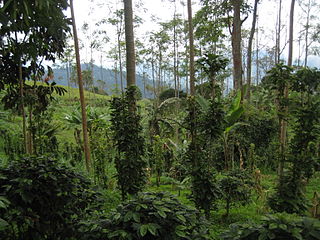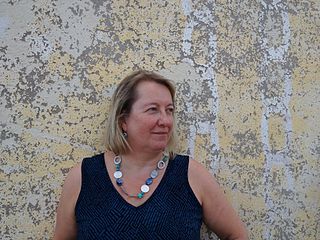Related Research Articles

Sustainable agriculture is farming in sustainable ways meeting society's present food and textile needs, without compromising the ability for current or future generations to meet their needs. It can be based on an understanding of ecosystem services. There are many methods to increase the sustainability of agriculture. When developing agriculture within sustainable food systems, it is important to develop flexible business processes and farming practices. Agriculture has an enormous environmental footprint, playing a significant role in causing climate change, water scarcity, water pollution, land degradation, deforestation and other processes; it is simultaneously causing environmental changes and being impacted by these changes. Sustainable agriculture consists of environment friendly methods of farming that allow the production of crops or livestock without causing damage to human or natural systems. It involves preventing adverse effects on soil, water, biodiversity, and surrounding or downstream resources, as well as to those working or living on the farm or in neighboring areas. Elements of sustainable agriculture can include permaculture, agroforestry, mixed farming, multiple cropping, and crop rotation.
Land management is the process of managing the use and development of land resources. One aim of sustainable land management is to prevent or reverse land degradation. Another aim is to ensure water security by increasing soil moisture availability, decreasing surface runoff, and decreasing soil erosion. Land resources are used for a variety of purposes which may include for example agriculture, forestry, water resource management, human settlements and tourism. Unsustainable land managements leads to land being over- or misused which in turn degrades the land, reduces productivity and disrupts natural equilibriums.
The Earth Institute is a research institute at Columbia University created in 1995 for addressing complex issues facing the planet and its inhabitants, with a focus on sustainable development. With an interdisciplinary approach, this includes research in climate change, geology, global health, economics, management, agriculture, ecosystems, urbanization, energy, hazards, and water. The Earth Institute's activities are guided by the idea that science and technological tools that already exist could be applied to greatly improve conditions for the world's poor, while preserving the natural systems that support life on Earth.
Reid Bryson was an American atmospheric scientist, geologist and meteorologist. He was a professor emeritus of the University of Wisconsin–Madison. He completed a B.A. in geology at Denison University in 1941 and a Ph.D. in meteorology from the University of Chicago in 1948. In 1946 he joined the faculty of the University of Wisconsin–Madison, and in 1948 he became the founder and first chairman of the University of Wisconsin-Madison's Department of Meteorology and Center for Climatic Research. He was the first director of the Institute for Environmental Studies in 1970.

A sustainable food system is a type of food system that provides healthy food to people and creates sustainable environmental, economic, and social systems that surround food. Sustainable food systems start with the development of sustainable agricultural practices, development of more sustainable food distribution systems, creation of sustainable diets, and reduction of food waste throughout the system. Sustainable food systems have been argued to be central to many or all 17 Sustainable Development Goals.

Ruth S. DeFries is an environmental geographer who specializes in the use of remote sensing to study Earth's habitability under the influence of human activities, such as deforestation, that influence regulating biophysical and biogeochemical processes. She was one of 24 recipients of the 2007 MacArthur Fellowship, and was elected to the United States National Academy of Sciences in 2006.
The term food system describes the interconnected systems and processes that influence nutrition, food, health, community development, and agriculture. A food system includes all processes and infrastructure involved in feeding a population: growing, harvesting, processing, packaging, transporting, marketing, consumption, distribution, and disposal of food and food-related items. It also includes the inputs needed and outputs generated at each of these steps.
The environmental impact of agriculture is the effect that different farming practices have on the ecosystems around them, and how those effects can be traced back to those practices. The environmental impact of agriculture varies widely based on practices employed by farmers and by the scale of practice. Farming communities that try to reduce environmental impacts through modifying their practices will adopt sustainable agriculture practices. The negative impact of agriculture is an old issue that remains a concern even as experts design innovative means to reduce destruction and enhance eco-efficiency. Animal agriculture practices tend to be more environmentally destructive than agricultural practices focused on fruits, vegetables and other biomass. The emissions of ammonia from cattle waste continue to raise concerns over environmental pollution.
John D. Hamaker (1914–1994), was an American mechanical engineer, ecologist, agronomist and science writer in the fields of soil regeneration, rock dusting, mineral cycles, climate cycles and glaciology.
At the global scale sustainability and environmental management involves managing the oceans, freshwater systems, land and atmosphere, according to sustainability principles.

Diana Liverman is a retired Regents Professor of Geography and Development and past Director of the University of Arizona School of Geography, Development and Environment in the College of Social and Behavioral Sciences in Tucson, Arizona.

Cynthia E. Rosenzweig is an American agronomist and climatologist at NASA Goddard Institute for Space Studies, located at Columbia University, "who helped pioneer the study of climate change and agriculture." She is an adjunct senior research scientist at the Columbia Climate School and has over 300 publications, over 80 peer-reviewed articles, has authored or edited eight books. She has also served in many different organizations working to develop plans to manage climate change, at the global level with the IPCC as well as in New York City after Hurricane Sandy.

The contributions of women in climate change have received increasing attention in the early 21st century. Feedback from women and the issues faced by women have been described as "imperative" by the United Nations and "critical" by the Population Reference Bureau. A report by the World Health Organization concluded that incorporating gender-based analysis would "provide more effective climate change mitigation and adaptation."

Erle Christopher Ellis is an American environmental scientist. Ellis's work investigates the causes and consequences of long-term ecological changes caused by humans at local to global scales, including those related to the Anthropocene. As of 2015 he is a professor of Geography and Environmental Systems at the University of Maryland, Baltimore County where he directs the Laboratory for Anthroecology.

Kate A. Brauman is an American scientist who uses an interdisciplinary tool set to examine the interactions between land use change and water resources. Brauman is the lead scientist for the Global Water Initiative at University of Minnesota's Institute on the Environment.

Karen Ching-Yee Seto is a geographer, urbanisation and land change scientist, and Frederick C. Hixon Professor of Geography and Urbanisation Science at Yale University. She is an expert on urbanisation and sustainability, and satellite remote sensing. She was the co-lead for the chapter on urban mitigation in Intergovernmental Panel on Climate Change (IPCC) 6th Assessment Report and IPCC 5th Assessment Report. From 2014 to 2020, she was the co-editor-in-chief of the scientific journal Global Environmental Change. She is an elected member of the U.S. National Academy of Sciences (NAS), the Connecticut Academy of Science and Engineering (CASE), the American Academy of Arts and Sciences, the Council on Foreign Relations, and a fellow of the American Association for the Advancement of Science (AAAS).
Rattan Lal is a soil scientist. His work focuses on regenerative agriculture through which soil can help resolve global issues such as climate change, food security and water quality. He is considered a pioneer in soil-centric agricultural management to improve global food security and develop climate-resilient agriculture.

Lenore Newman is a Canadian author and geographer. She is Associate Professor of Geography and the Environment at the University of the Fraser Valley and Director of the Food and Agriculture Institute. She holds a research chair in food and agriculture innovation and is a past Canada Research Chair in Food Security and the Environment.
Molly Jahn is an American plant geneticist and breeder and Professor of Agronomy at University of Wisconsin-Madison, USA. She was Under Secretary of Research, Education and Economics in the U.S. Department of Agriculture.

Jessica Fanzo is an American scientist. She is a Professor of Climate and Director of the Food for Humanity Initiative at the Columbia Climate School. Prior to joining Columbia in July 2023, she was the Bloomberg Distinguished Professor of Global Food and Agriculture Policy and Ethics at the Johns Hopkins Berman Institute of Bioethics, the Bloomberg School of Public Health, and the Paul H. Nitze School of Advanced International Studies. She was the first laureate of the Carasso Foundation’s Sustainable Diets Prize in 2012 for her research on sustainable food and diets for long-term human health. In 2024, Fanzo was elected a member of the National Academy of Sciences.
References
- ↑ "Geography professor Navin Ramankutty is challenging students in the Sustainability, Science and Society program to come up with ways to feed the world in 2050 when climate change and natural disasters like this flooding near Fargo, N.D., affect the amount and usefulness of good arable land.". Scott Olson, GETTY IMAGES FILE, The Gazette , 05.11.2011[ clarification needed ]
- ↑ "Farming in a Changing Climate". The Agenda, TVOntario, aired October 26, 2015.
- ↑ "Can organic be profitable? If the price is right, WSU study says". Seattle Times, June 1, 2015
- ↑ Andrew M. Barton; Alan S. White; Charles V. Cogbill (2012). The Changing Nature of the Maine Woods. UPNE. pp. 113–. ISBN 978-1-61168-295-3.
- ↑ "Crops play a major role in the annual CO2 cycle increase". University of Wisconsin-Madison, Nov. 19, 2014, by Kelly April Tyrrell
- ↑ Committee on Scientific Accomplishments of Earth Observations from Space (17 December 2007). Earth Observations from Space:: The First 50 Years of Scientific Achievements. National Academies Press. pp. 139–. ISBN 978-0-309-18566-0.
- ↑ New Scientist. New Science Publications. 2008. p. 14.
- ↑ "Is there room for organics? ", Cosmos, 17 Feb 2014
- ↑ Google Scholar Report